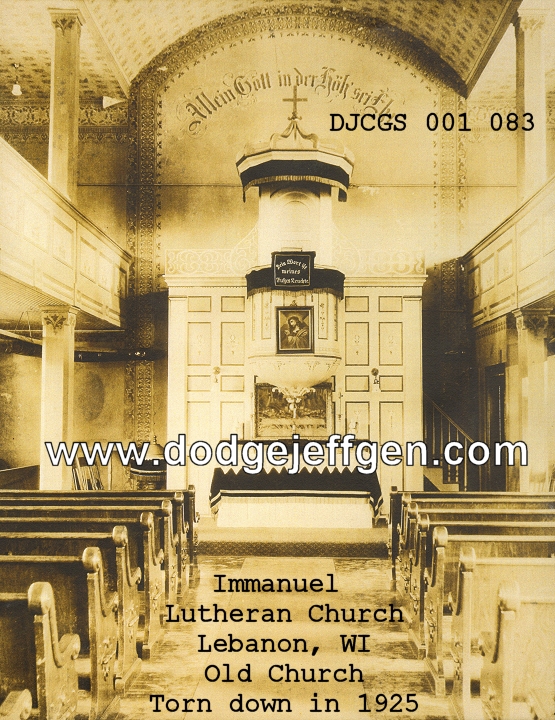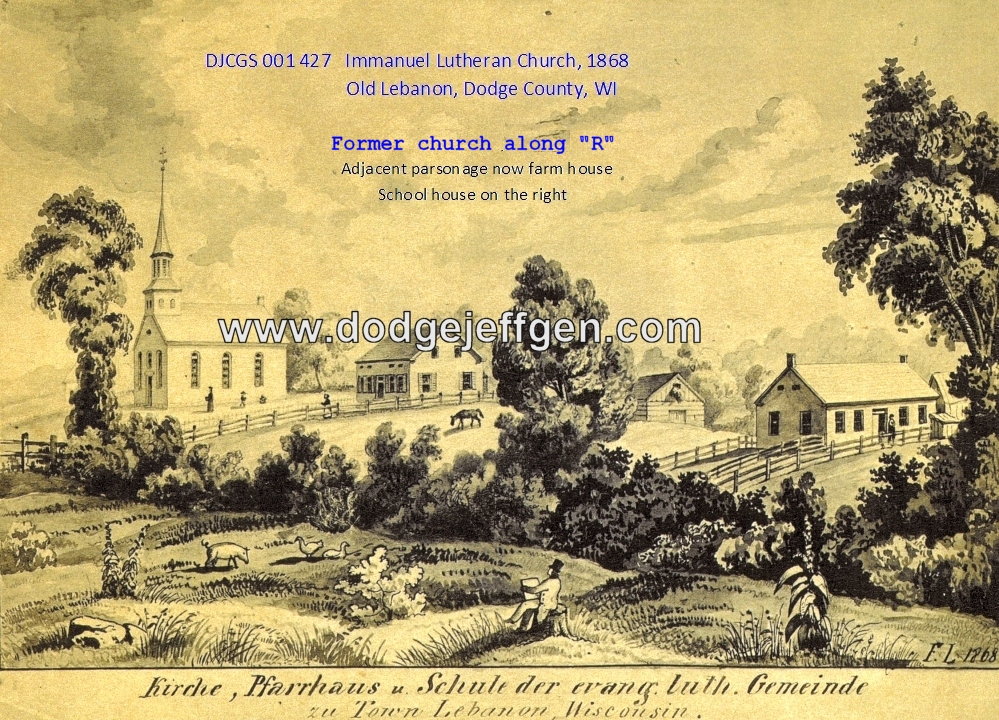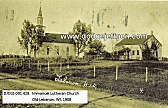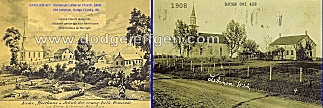This file part of www.dodgejeffgen.com
website
Immanuel
Lutheran Church
Lebanon
Old Church


Watertown Daily Times, 03 13 1984
LEBANON - Immanuel Lutheran Church in Lebanon rededicates the facility in three special services Sunday. The rededication follows an extensive remodeling program and also places special emphasis on the 140th anniversary of the founding of the congregation. Only a few months in the process, the entire church has been redecorated with new carpeting, pews and radiator covers. The redecoration of the basement fellowship hall and kitchen has also been completed. The project began Jan. 3 and Sunday's services signify completion of the undertaking.
Immanuel
Church to note 165th anniversary
Watertown Daily Times, 09 08 2009
LEBANON - Immanuel Lutheran Church of Lebanon will be celebrating its 165th anniversary with special worship services Sunday.
The church was founded in the fall of 1843 by the Pomeranians and Oderbruechers (from Brandenburg, Germany) who settled in Lebanon. They fled their native homelands for religious freedom. The Pomeranians were Lutheran since the time of the Reformation.
The Oderbuecher settlers of Lebanon were direct descendants of confessional Lutherans forced out of Catholic German areas in 1588 to Salzburg and other parts of Europe.
The Pomeranians came early to Milwaukee about Aug. 15, 1843, and waited for three weeks for the first group of Oderbruechers who arrived Sept. 6 and 7, 1843. The men in these early groups left their families in Milwaukee and walked to Lebanon. The first group left Milwaukee on Sept. 21 and arrived seven days later on Sept. 28, 1843, traveling through Pipersville to Lebanon.
According to Johann H. Moldenhauer Sr. who was 12 in 1843, the first church service was held outside under the oak trees in a field west of Rock Hill. Six miles away in Watertown, English speaking residents came to see who was singing so loud and found the German speaking settlers.
The Pomeranians settled around old Lebanon, and Oderbruechers went to the east of Lebanon to the marshland called Sugar Island.
Another early worship service was held in the home of Joachim Krueger and then for a whole year in the home of Johann Korth by laymen.
Rev. Kindermann served Immanuel until September 1844. In June 1844, Rev. Kindermann confirmed the first class. The first wedding was Carl F.W. Setzkorn and Dorothea L. Moldenhauer in September 1844, performed by Rev. Kindermann.
Rev. Kindermann joined the Buffalo Synod whose leader was Rev. Grabau.
The congregation made arrangements to build a log church with parsonage attached. It was dedicated in 1845.
In 1846, the first schoolhouse was built with living quarters for a teacher. Erdmann Pankow was installed as teacher. On April 7, 1846, at the home of Christian Dornfeld, the township voters organized their government. The name Lebanon was chosen by Christian Dornfeld, Wilhelm Setzkorn and Wilhelm Woltmann.
In 1846 Erdman Pankow was the teacher at Immanuel and used the violin to teach music to the children. The Pankow congregation built their own church, Evangelical Lutheran, St. Paul's of Lebanon in 1854 at the north end of Old Lebanon. It was the first brick church in Lebanon.
In 1856, teacher Philipp Wetzel and other members objected to private confession that Rev. Geyer insisted on. One hundred members broke away and formed St. Matthew's congregation and built their own church on the south end of Old Lebanon. It disbanded in 1926.
In November 1860, the congregation voted to build a brick church 35 by 55 with a steeple and balcony. The cornerstone was laid June 9, 1861. In 1862 a new brick parsonage was built. In 1863 a new North school house with teachers' living space was built three miles north of the church with H. Falk as teacher. In 1864 a new brick school house with a dwelling for the teacher was erected at the south site.
In 1905, Rev. Pankow retired and St. Paul's congregation dissolved. The remaining members joined Immanuel, St. Mark's Lutheran Church and St. Paul's Lutheran Church in Sugar Island.
In 1910, upon the death of Rev. Allwardt, Rev. William Lange was called and served until 1937. A new church was voted on, the last service in the old church was held on March 15, 1925. Then it was taken down. The cornerstone of the new brick church, today's present church, was laid May 24, 1925, and dedicated Oct. 25, 1925.
The cost was $44,528.86.
Cross References:
WELS Historical Institute Journal, “Old Lutheran Settlements in Wisconsin, April, 1998, p.25
WELS Historical Institute Journal, “1843 a.d. plus, October, 2006, p.17
Patriotic school-age members. Undated picture [if link broken, same as WHS 001 642
First School. Undated picture [if link broken, same as WHS 001 641]

